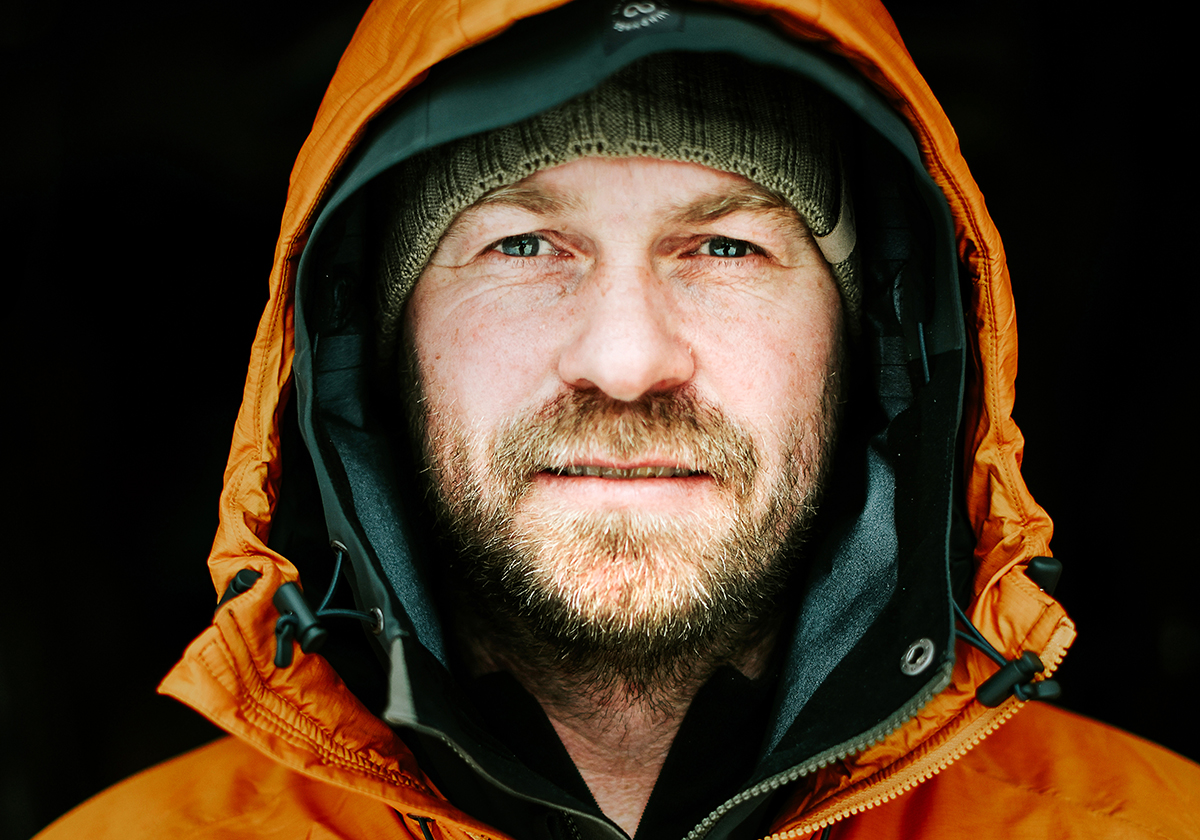How to: Pack your backpack
To make a hike or alpine ski tour as comfortable as possible, how you pack what you will be carrying is not unimportant. If you consider that your center of gravity goes from the center of the body and spinal cord, it’s here where the heavy things in your packing should be. A lower center of gravity essentially gives you better balance, which can be useful when, for example, going skiing. A somewhat higher center of gravity can be comfortable when hiking. Because of his work as hardware product developer for Lundhags, Håkan does almost nothing else but pack backpacks. If not to exaggerate. He says that, in an actually surprising context, that less is not always more. The trendy minimalism can instead make the outdoors unnecessarily exciting.

Don’t praise the minimal, Håkan. Elaborate.
– I understand that it’s more comfortable to carry less. But when it becomes a competition to pack as light and as little as you can, this brings with it risks and less comfort. Sure, if you enjoy sleeping without a sleeping pad, then that is what you should do. But if you would like a little more comfort and perhaps even bring along a salami and something good to drink, I at least think that it’s nicer. I think that you have to weigh in the term comfort.
– Even when I design and test backpacks, I avoid the most minimalistic. There has to be a margin so that the product actually handles the worst possible scenario. As when I bring an extra ration of food and an extra layer, I want the backpacks that we design to handle the unexpected, when equipment is put to an extra difficult test.
What is it that is “Lundhags”, so to say, with backpacks that you have designed and tested, Håkan?
– My job is to create products that breathe Lundhags’ core values. Both on paper and purely practical. We work, for example, a great deal with natural weaves that should also feel like natural weaves. Often when designing something, I begin by thinking about how Lundhags thought about boots. Lundhags boots have soul. It is about generations of substantial craftsmanship know-how. The materials are often leather, metal, natural rubber – all rugged gear that ages with dignity. I also want this reflected in our backpacks.
I constantly get inspiration from this, even if we can’t make a backpack like a shoe or in the exact same material as a boot. But we want the customer to feel that this is a Lundhags backpack. An expressive example is that we have metal buckles on all of our backpacks. Of course, this is because a metal buckle is better for both you and the environment, and lasts longer than plastic, for example. Naturally, metal buckles cost more than plastic, but it is much more “Lundhags”, thanks to this. We also use our LPC fabric (Lundhags PolyCotton) in the backpacks. It gives a special character. Just to name some examples. Backpacks, like our boots, should simply be genuine, functional, sustainable (in both ways) and convey our Scandinavian heritage.
What is most important to think about when choosing a backpack?
– I think adjustment possibilities. The most important is that you can adjust the backpack so that it fits your body, your torso. Then, when you fill the backpack, you have to consider how you pack. Know where to place things to get as much comfort as possible. Weight distribution is one thing. To differentiate right from left, so that the center of gravity is in the middle, as close as possible to the spine so to say – classic physics. You want as little moment as possible. I pack so that the center of gravity is somewhat higher in the summer compared to winter, since a lower center results in more effective and more enjoyable skiing.
How large of a backpack do I need?
– Generally, you need more gear on a winter tour. But you can say that 60 liters is about what you start with if hiking in the forest or mountains for a week. Then it depends on how much comfort and food you want to bring along. A tent needs more space and you’re up to 90 or 100 liters. A 50-liter pack can be perfect on a hut tour, where you don’t need a tent or stove. 40 liters or less can be used on everything from one to two-day tours.
You’re an expert in packing, safety and the outdoors. But, can you please tell us about the tampon incident?
– (Ha, ha), it figures that you would bring that up. But ok. I had grown accustom to not being so careful about packing first aid on short day tours. It was last winter and my partner and I were supposed to be out only during the day. I wanted to chop some wood for the fire, but put the axe in my knee. Through fives layers of clothing. As luck would have it, my partner had an elastic bandage. And tampons. Tampons proved to be perfect as a pressure bandage. Since then, I’m always careful about bringing first aid. And tampons.
Packing right - Six simple tips from Håkan
Pack heavy things closest to the spine. You get the best balance if you aim to center the weight. (Example: liquids, cooking gear, stove fuel and food)
- Light stuff can be packed farther from the spine, since it affects balance less. (Example: clothing, slippers, and seat och sleeping pads).
- You pack things that are often used or that you want to get to quickly highest up in the pack or in the top pocket. (Example: snacks, first aid, gloves, hat and rainwear).
- Seldom used things are packed furthest down. (Example: Stuff that you won’t use until setting up camp. Sleeping bag, toiletry kit, stove and towel).
- Packing in a waterproof bag can save a lot trouble, both when it rains and when searching for something.
- The most important tip is to practise packing. And this is done by being out a lot. You then learn what works and what doesn’t work, what you need and what you don’t.
ABOUT HÅKAN
Name: Håkan Nyström
Occupation: Hardware product developer and designer for Lundhags (in Järpen).
Days outside: Two days per work. Regardless of weather and season.
Born and raised: Avesta
Lives: Undersåker in Jämtland
Interests: Outdoors and a lot of fishing.
Always packs: fishing gear, tinderbox, light grill (320 grams including grate and support legs) and first aid (tampons, elastic bandage, two types of pain killers, self-hardening pasta for provisional filling, Band-aids, military first aid – packaged, tweezers, suture tape, clasp knife and small scissors).
Equipment list
TO CARRY
Backpack
Backpack rain cover
Packing bags/drybags t
TO WEAR
Extra layer
Wind or waterproof jacket
Wind or waterproof pant
Sweater, insulated
Long underwear top, wool
Long underwear pant, long, wool
Long underwear pant, short, wool
Thin and thick socks, wool
Hat/cap/buff
Thin gloves
Gloves with removable liner
Boots/shoes/ski boots
Camp/wading/hut shoes
Shorts
T-shirt, wool
Snow gaiters
CHANGE OF CLOTHES
Long underwear top, wool
Long underwear pant, long, wool
Long underwear pant, short, wool
Thin and thick socks, wool
Hat
NAVIGATE
Map
Compass
GPS
CAMP KITCHEN
Stove
Fuel
Lighting material
Vacuum bottle/bottle
Cutlery
Mugg/cup
Dishwashing gear
Food and drink
OTHER
Touring skis, steel edges
Touring poles, large basket
Skins and ski waxes
Googles
Sunglasses
Camera/binoculars
Headlamp
Tent lamp
Whistle
Emergency wind sack
Sitting pad
Knife/multi-tool/ax
Power bank/extra batteries
Safety line
Repair kit (for example pliers, tape, string, super glue, etc)
Hiking poles
Cell phone
Snow brush
Trash bag
CARE/HYGIEN
Small towel
First aid
Blister pads
Band-aids
Sunscreen
Toothbrush/toothpaste
Soap/shampoo
Toilet necessities and medicine
Toilet paper
Backcountry trowel
Mosquito repellent/insect protection
Pain killers/fever medicine
Suture tape
SLEEPING
Tent/tarp
Sleeping bag
Sleeping bag liner
Sleeping pad
Remember to carry out your trash, and that of others as well, for recycling.
